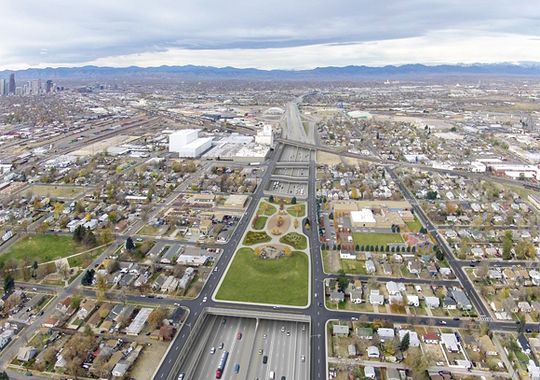I-70 Widening Has Already Diverted $50M From Smarter Transpo Projects

Whether it’s the marginalization of Globeville, Elyria, and Swansea residents, the stark threat of respiratory illness, or the simple fact that widening roads does not solve traffic congestion, the I-70 expansion planned between Brighton Boulevard and Tower Road is a terrible idea. Still, the highway project with a $1.8 billion starting price tag has a lot of political momentum.
Streetsblog looked into the funding mechanisms for one of the most expensive road projects in Colorado history, and it turns out that the I-70 widening is already diverting money from other priorities.
As insiders tracking the project know, the Denver Regional Council of Governments skimmed $50 million in federal funds “off the top” to fund the I-70 project before considering others. In other words, DRCOG’s decision prioritized widening the highway to 10 lanes instead of spending on projects that can improve safety, reducing greenhouse gas emissions, or connect people to jobs via effective transit. (Having been just a twinkle in the city’s eye during the decade-long debate of this plan, Streetsblog Denver is playing a little catch-up.)
Here’s what else $50 million could buy:
- About 300 miles of protected bike lanes, enough to create an effective citywide network.
- One year’s worth of RTD passes for 52,742 people.
- 296 miles of badly needed sidewalks, or 20,408 high-visibility crosswalks.
DRCOG manages the flow of federal transportation money to the Denver region (which somehow includes Weld County). Representatives from 56 metro area governments comprise the council, which is responsible for deciding which projects get funded and which don’t. So DRCOG meetings are like a miniature UN, its members both cooperating and competing for funds.

But on June 25 of last year there was no dissent on the board. It unanimously approved the $50 million contribution to the I-70 project after a formal request from the Colorado Department of Transportation — despite the warnings of City Auditor Dennis Gallagher. Just two days prior, in a scathing letter, Gallagher had laid out his case against the project:
“I do not believe that CDOT has made a credible case for the need to widen the highway to ten lanes and is basing that preference on outdated and inaccurate data and information. So, I encourage you, as stewards of some of those limited resources to be certain as you authorize the expenditure… that the plan upon which those funds will be expended is appropriate, necessary and actually grounded in fact not fantasy.”
The $50 million contribution went forward, though, along with allocations for other road projects. In the end, 69 percent of the $266 million in federal funds went toward roads — and most of that went toward expansions, not maintenance. Only 28 percent went to transit, biking, and walking.
DRCOG Director of Transportation Planning and Operations Doug Rex said the vast majority of the road projects — he estimated 95 percent — include some sort of biking and walking feature. But that doesn’t excuse spending $50 million to make I-70 five lanes in each direction, especially since it’s been proven time and time again that widening roads creates more demand for driving, resulting in equal or worse congestion.
In fact, DRCOG’s appetite for road widening undermines its spending on other modes. By inducing more car traffic and facilitating spread-out development, the agency is making the region less walkable and bikeable. And with every road expansion, DRCOG is effectively shrinking the potential pool of riders for Denver’s light rail — another recipient of DRCOG funds — which works most efficiently when serving compact, walkable areas.
In its strategic plan, called “Metro Vision,” DRCOG sets goals “for reducing growth in mobile source air pollution emissions by providing travel alternatives, improving the efficiency of the regional transportation network and changing key features of the development pattern.”
Fixing the dilapidated viaduct on this portion of I-70 would be consistent with those goals, but widening it is not.


